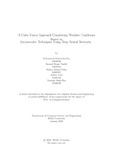| dc.contributor.advisor | Alam, Md. Ashraful | |
| dc.contributor.author | Raj, Mohammad Mainuddin | |
| dc.contributor.author | Tasdid, Samaul Haque | |
| dc.contributor.author | Nidra, Maliha Ahmed | |
| dc.contributor.author | Noor, Jobaer | |
| dc.contributor.author | Ria, Sanjana Amin | |
| dc.date.accessioned | 2021-10-19T09:07:25Z | |
| dc.date.available | 2021-10-19T09:07:25Z | |
| dc.date.copyright | 2021 | |
| dc.date.issued | 2021-01 | |
| dc.identifier.other | ID 16101066 | |
| dc.identifier.other | ID 16101131 | |
| dc.identifier.other | ID 16301111 | |
| dc.identifier.other | ID 16301210 | |
| dc.identifier.other | ID 17101059 | |
| dc.identifier.uri | http://hdl.handle.net/10361/15456 | |
| dc.description | This thesis is submitted in partial fulfillment of the requirements for the degree of Bachelor of Science in Computer Science and Engineering, 2021. | en_US |
| dc.description | Cataloged from PDF version of thesis. | |
| dc.description | Includes bibliographical references (pages 40-42). | |
| dc.description.abstract | Color vision approach is a riveting field of technology crucial in pioneering innovations like autonomous vehicles, autonomous drone deliveries, automated stores,
robots, infrastructure and surveillance monitoring programs for security, manufacturing defect monitoring and more. When it comes to real life applications of automated machines, safety is a major concern and to ensure utmost safety the unpredictable has to be taken into consideration. We propose and demonstrate a color
vision approach that allows image normalization hinged on autoencoder techniques
employing deep neural networks. The model is composed of image preprocessing,
encoding and decoding. The images are resized in preprocessing portion the images
go through a cognitive operation where the input image becomes suitable to enter the autoencoding technique section. The autoencoder is comprised of two core
components – encoder and decoder. To employ this system deep neural network is
applied which generates a code of an image in the encoding process. Sequentially,
the code changes over to decoding. Decoder portion decodes it and regenerates the
initial image extracting it from the code of the encoder portion. It allows normalizing color images under different weather conditions such as images captured during
rainy or foggy weather conditions. We devise it such that rainy and foggy images
are normalized concurrently. The autoencoder is trained with numerous rainy and
foggy datasets utilizing CNN. In this research, we investigate the model normalizing images in two different weather conditions – rainy and foggy conditions in real
time. We used SSIM and PSNR to verify the accuracy of the model and confirm
its capability reconstructing images in real time for advanced real life color vision
implementations. | en_US |
| dc.description.statementofresponsibility | Mohammad Mainuddin Raj | |
| dc.description.statementofresponsibility | Samaul Haque Tasdid | |
| dc.description.statementofresponsibility | Maliha Ahmed Nidra | |
| dc.description.statementofresponsibility | Jobaer Noor | |
| dc.description.statementofresponsibility | Sanjana Amin Ria | |
| dc.format.extent | 42 pages | |
| dc.language.iso | en | en_US |
| dc.publisher | Brac University | en_US |
| dc.rights | Brac University theses are protected by copyright. They may be viewed from this source for any purpose, but reproduction or distribution in any format is prohibited without written permission. | |
| dc.subject | Color Vision | en_US |
| dc.subject | Deep Neural Network | en_US |
| dc.subject | CNN | en_US |
| dc.subject | Autoencoder | en_US |
| dc.subject.lcsh | Neural networks (Computer science) | |
| dc.title | A color vision approach considering weather conditions based on auto encoder techniques using deep neural networks | en_US |
| dc.type | Thesis | en_US |
| dc.contributor.department | Department of Computer Science and Engineering, Brac University | |
| dc.description.degree | B. Computer Science | |

